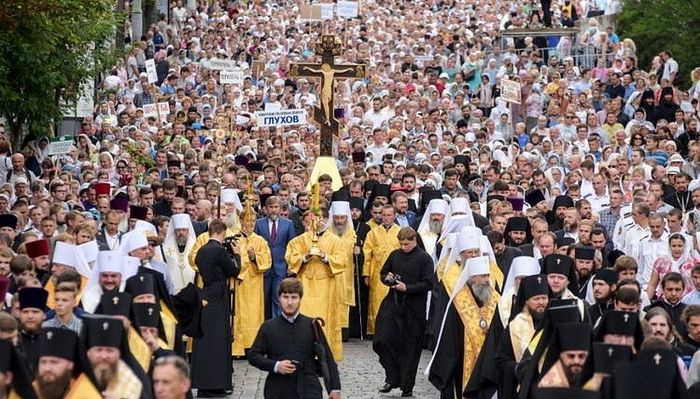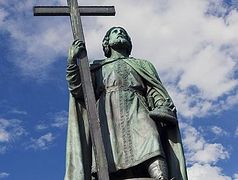Kiev, July 26, 2019
On July 27, 2019, on the occasion of the 1031st anniversary of the Baptism of Rus’, Kiev is preparing for the traditional cross procession. The festal cross procession is one of the most anticipated events of the year in the lives of believers, which attracts literally hundreds of thousands of faithful, in a show of dedication to their church and thanksgiving for the Baptism of Rus’.
Festivities will begin at 10:00 AM on July 27, where believers will process onto Vladimir’s Hill, which overlooks the River Dnipro, where the peoples of ancient Rus’ received Baptism in the year 988, under Equal-to-the-Apostles St. Vladimir, Grand Prince of Kiev and All Rus’.
At 1 PM, a thanksgiving moleben will be served there by His Beatitude, Metropolitan Onuphry of Kiev and All Ukraine, together with a great host of hierarchs of the Ukrainian Orthodox Church, as well as representatives of the Serbian Church and the Church of the Czech and Slovak Lands.
At 1:30 PM, the Grand Cross Procession will begin to Kiev Caves Lavra; after clergy and pilgrims arrive at the Lavra, a vigil will be served.
On July 28, at 9 AM, on the square in front of Dormition Cathedral of Kiev Caves Lavra, Metropolitan Onuphry will lead a Festal Divine Liturgy with hierarchs of the UOC, and other Local Churches. As Orthochristian previously reported, after the end of the liturgy, three new saints are to be glorified. They are Archbishop Vasily (Bogdashevsky) of Kanev (+ 1933), Bishop Sylvester (Malevansky) of Kanev (+ 1908), and Archpriest Alexander Glagolev (+ 1937).
The two Holy Hierarchs were both rectors of the Kiev Theological Academy, which was founded by St. Peter (Mogila), Metropolitan of Kiev, Galicia, and All Russia, as the first Orthodox seminary not only in Rus’, but in the whole world. Fr. Alexander was a professor there, and so the three shall be added to the Synaxis of the Saints of the Kiev Theological Academy, which begins with the Holy Hierarch Peter.
Those who attend festivities will also have the opportunity to venerate the relics of several saints being brought out. This includes the famous surgeon-bishop St. Luke of Crimea, and the final ataman (general) of the Zaporizhian Cossack host, St. Petro Kalnyshevsky. Another incredibly important saint, whose relics will be available for veneration is St. Lawrence of Chernigov. Few saints are more relevant when discussing the Ukrainian Crisis, as he famously prophesied and accurately predicted events happening in Ukraine now. Here is one of his most famous quotes:
“As it is impossible to divide the Most Holy Trinity, Father and Son and Holy Spirit, for it is One God, so also it is impossible to divide Russia, the Ukraine and Belorussia, for these together are Holy Rus'. Know, remember, and do not forget.”
Another saint whose relics will be brought out is St. Alexy the Carpatho-Russian, who we discussed in the second part of a two-part series on the history of the Rusyns and Orthodoxy in Transcarpathian Rus’. His story is particularly relevant in discussing the Ukrainian issue, as the saint hails from Subcarpathian Rus’, which is now part of the Transcarpathian (Zakarpattia) Province of Ukraine.
St. Alexy, however, was born a Rusyn, and did not wish to be identified as Ukrainian, though not because he had anything against Ukrainians, as he regarded all Rus’ people to be one, which is the traditional view of saints in Russia and Ukraine. Rather, St. Alexy remembered that Rusyn was in fact, the original name for an inhabitant of Western Ukraine, and the Orthodox people who called themselves Rusyns were often persecuted by Greek Catholics supported by Austro-Hungary.
During St. Alexy’s time, Transcarpathia was part of Czechoslovakia, and after WW2, the saint, understanding the Soviets intended to annex this pious land, urged them not to force the people into Soviet Ukraine, but to create a separate autonomous republic for Rusyns. The godless authorities would refuse, and Stalin and Khrushchev brutally persecuted and suppressed Rusyn identity, deporting many Rusyns and Galicians to Soviet Ukraine, as being Carpatho-Rusyn was seen as attached to the idea of Holy Russia, an idea which the Bolsheviks hated, as it was born not of nationalism, but of the Baptism of Rus’.
The importance of the Baptism of Rus’ cannot be overstated. St. Lawrence constantly reminded his fellow Ukrainians that “it’s absolutely necessary to know, remember, and not forget that it was the Baptism of Rus’, and not the baptism of Ukraine.” As we discussed concerning Rusyns, St. Lawrence explained that “the word for our native land [Ukraine] and people is Rus’ and Russian.” St. Lawrence explained that the word Ukraine means borderland or “outback”, and was meant with reference to Rus’, however occupiers of the Ukrainian lands wanted Ukrainians to forget this national connection. It is worth noting today that essentially all Ukrainians consider themselves children of Rus’, the issue is simply some ultra-nationalists claim that Rus’ is “ancient Ukraine”, and Russia has no connection to Rus’.
The Baptism of Rus’ is so important, however, because it is a constant reminder that the Orthodox faith predates all these nations, and it was Orthodoxy which created the nation itself, and all its national culture. There would be absolutely no Russian culture without this Baptism — imagine Russia without St. Basil’s Cathedral, St. Petersburg, the Moscow Kremlin, and the works of Dostoyevsky, Tchaikovsky, and Tolstoy. Russia would be completely unrecognizable. The same could be said with Ukraine: Imagine Kiev without the Lavra, St. Andrew’s Church, St. Sophia’s Cathedral, and Golden Domed St. Michael’s Monastery, or the works of Gogol and Shevchenko. It is only with these things, that Kiev not only becomes recognizable, but also recognized as the Baptismal Font from which all Russia gained its faith.
This is why the Baptism of Rus’ is so crucial, as it is literally the birth of the people’s identity they are celebrating.
These cross processions, as noted before, are also excellent opportunities for the people of Ukraine to display their loyalty to the Ukrainian Orthodox Church led by Metropolitan Onuphry before the whole world.
In 2017, the UOC procession attracted over 100,000 believers, which can be seen here vastly outnumbering the schismatic Kiev Patriarchate, which had attracted around 2000 as seen in the same video here.
Last year, in 2018, the UOC procession grew to 250,000, and the schismatic procession was bolstered only by the direct support of the Ukrainian president and state, as the Union of Orthodox Journalists reports.
That Union also released an English language YouTube video comparing the canonical procession with the schismatic one of 2018. Of note, rather than singing prayers, many of the schismatics proceeded as if this was a political rally, and literally called out “death to the enemies” as they marched.
This year will be the first year, however, that a procession will be held after the Phanar formed the schismatic OCU. It is reported that Patriarch Bartholomew will send a delegation to serve with them. Theoretically, the “Honorary Patriarch” of Kiev, Philaret would have attended the procession, however in less than a year, Philaret already managed to form a schism within the OCU, and therefore, he will celebrate separately.
All eyes are now on Kiev, and the Cross Procession to come.
Follow us on Facebook!




